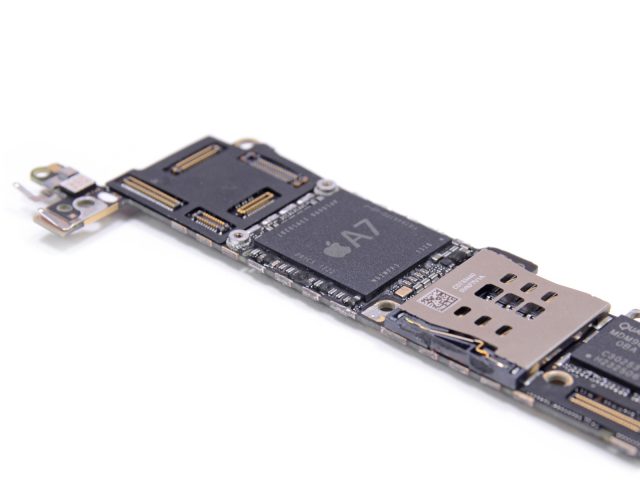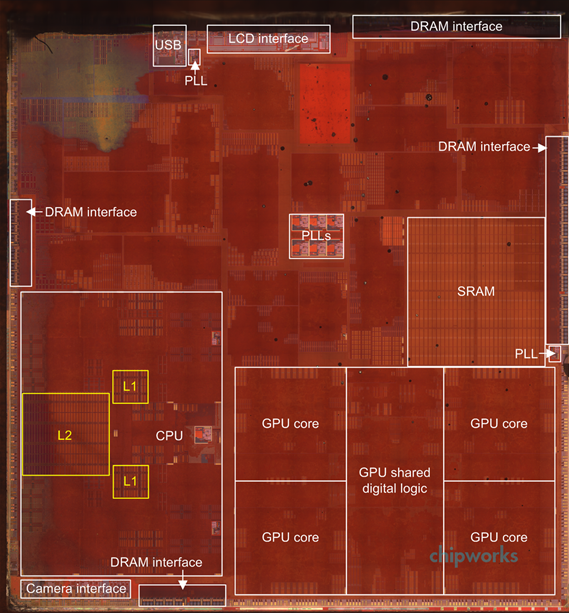
When Apple announced its new iPad Air and Retina iPad mini in San Francisco last week, one of the most surprising revelations was that the tablets would both be powered by the same Apple A7 chip used by the iPhone 5S. Since the third-generation iPad was released in early 2012, the vastly different display resolutions of the phones and tablets (1136×640 for iPhones, 2048×1536 for iPads) meant that different chips were needed. Smaller chips like the A5 and A6 were used to meet the power requirements of the phones, while the A5X and A6X picked up more powerful GPUs and wider memory interfaces to drive the tablets' larger displays.
Early reviews of the iPad Air were posted last night, and as usual Anand Shimpi of AnandTech had the most detailed information to share about the tablet's innards. The short version? For the first time since the iPad 2 and iPhone 4S shared the A5 SoC back in 2011, the flagship iPhones and iPads are using the same silicon.
Making the numbers add up
Let's begin with Apple's performance promises. Apple said that the A7 in the iPhone 5S could often double the CPU and GPU performance of the A6 in the iPhone 5, and our review bore these observations out. Apple also said that the A7 in the new iPad Air and the Retina iPad mini could deliver roughly double the CPU and GPU performance of the A6X in the fourth-generation iPad. And yet, the A6X offers roughly twice the GPU power of the A6—our biggest question coming out of the iPad announcement last week was just how all of these statements could be true if the iPhone and iPad were using the same chip.
The A7 in the iPhone 5S gives you two of Apple's 64-bit ARMv8 "Cyclone" CPU cores, an Imagination Technologies PowerVR G6430 GPU, 1GB of LPDDR3 RAM, and a 64-bit memory interface—all built on Samsung's 28nm process. Shimpi says that the iPad Air uses the same chip at a hardware level, just in a different configuration. For example, the iPad Air's A7 runs at a base CPU clock speed of 1.4GHz, up very slightly from the 1.3GHz of the iPhone 5S. Further clock speed increases are probably theoretically possible, but increasing clock speeds by large amounts requires a correspondingly large amount of power. It is not an ideal way to increase performance.
Because the iPad is larger and leaves Apple more room to dissipate heat, the iPad's A7 can also sustain higher CPU clock speeds for longer periods of time.

Shimpi's chart shows that, under extreme load, the A7 chips in both the iPhone 5S and iPad Air run at their maximum clock speeds for about two minutes. At that point the A7 in the iPhone 5S drops off sharply to about 1.0GHz to prevent overheating, while the A7 in the iPad Air gradually decreases in speed throughout the duration of the test but is generally able to maintain a higher level of performance throughout. Many phone and tablet workloads don't call for this kind of performance over this long of a period, but over time, the A7 in the iPad can significantly outperform the A7 in the iPhone just by having more room to stretch its metaphorical legs.
These small tweaks also apply to the GPU, though it's more difficult to determine GPU clock speed in an SoC than CPU clock speed. Shimpi believes the clocks have only been increased by a very small amount over the iPhone 5S if they've been increased at all—by around five percent, if that.
The increased thermal headroom in the tablet is again responsible for the lion's share of the performance gains. The iPad Air's GPU is faster than both the iPhone 5S' and the fourth-generation iPad's, but it rarely manages to double performance relative to the old iPad in the benchmarks that are being used. In the GFXBench 2.7 GPU benchmarks (the same we run for our reviews here), the A7 ended up being between 66 and 75 percent quicker than the fourth-generation iPad in the more strenuous T-Rex HD test, but only around 20 percent faster in the older Egypt HD test. Apple's "up to" figures for performance increases are usually more representative of typical performance, but in this case you have to take them with a grain of salt—the A7 can come close to doubling the A6X's GPU performance sometimes, but the gains are usually smaller.
What's impressive from a technical standpoint is that Apple can deliver improved GPU performance despite providing less memory bandwidth—the A7 has a 64-bit memory interface like the A5 or A6, while both the A5X and A6X used 128-bit interfaces. Apple has apparently reduced the need for this wider memory interface by integrating 4MB of SRAM into the A7 SoC itself, which acts as a cache that reduces the number of times the SoC has to communicate with the (larger, slower) system memory. This approach to improving overall performance is not uncommon. Intel's Iris Pro 5200 integrated GPU uses 128MB of eDRAM for essentially the same purpose, while both the Xbox 360 and Xbox One are using integrated RAM (eDRAM in the 360, eSRAM in the One) to serve as a memory buffer.

While Shimpi's evaluation of the A7 is mostly glowing, he did identify the 1GB of system RAM as a potential bottleneck. He compared the 32-bit and 64-bit versions of iOS 7.0.3 while performing a few common tasks and came to the conclusion that the 64-bit version running on the A7 generally uses between 20 and 30 percent more RAM than the 32-bit version running on older SoCs. Apple's aggressive memory management has meant that iOS devices have almost always gotten by with less RAM than contemporary Android gadgets (almost all high- and mid-end Android phones and tablets have graduated to 2GB of RAM, while the very newest are beginning to include 3GB), but Shimpi noticed a few crashes on the iPad Air that seemed to be related to low memory errors.
Our review of the iPad Air will be published early next week after the tablet has been released to the public. In the meantime, we'll keep an eye out for further technical information about the iPad Air and Retina iPad mini, as well as the tidbits provided by product teardowns from the likes of iFixit and Chipworks.
reader comments
104